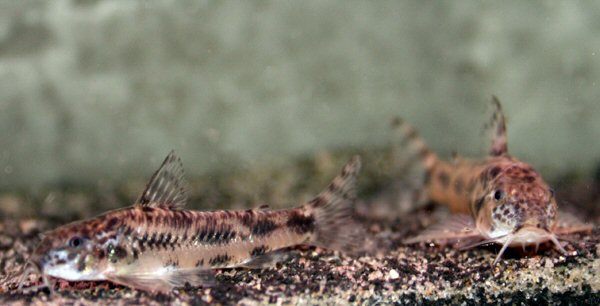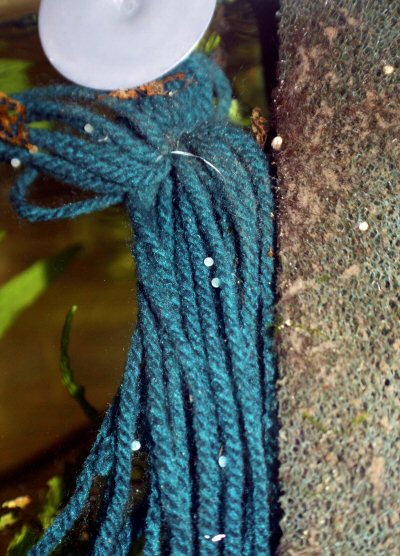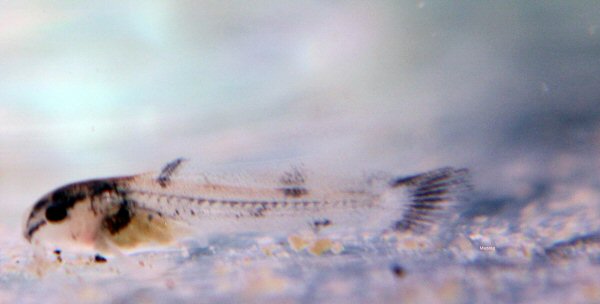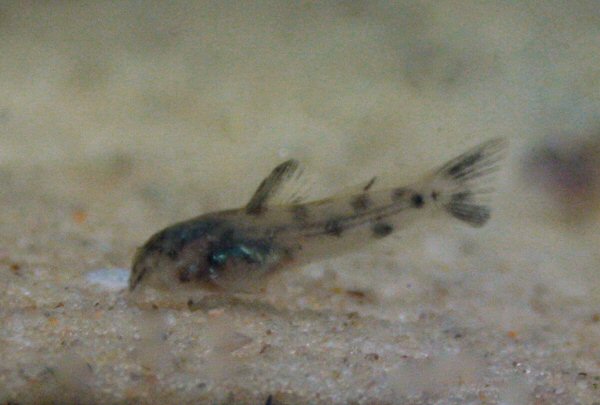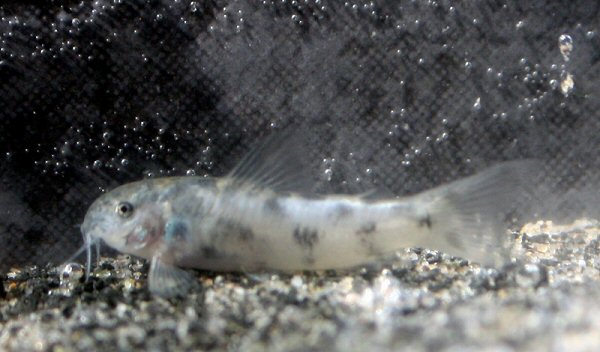SCOTCAT.COM
your internet guide to all things catfish
| Spawning Aspidoras sp. CW052 'Black fin' |
by Adrian Taylor |
My small group were obtained from Ingo Seidal and consisted of 3 males and 3 females in 2012. They were housed in a small aquarium, having the following dimensions: Length: 40cm, Width and height both 16cm. Which was filtered by an air powered matten filter having a moderate airflow, and had a sand substrate, and apart from a clump of java moss the only other piece of decor was an artificial nylon spawning mop, which was hung close to the matten filter outlet. After feeding the group on an alternate diet of crushed commercial flake food and microworms and carrying out 20% water changes every 7 days or so for a month or two, I set about conditioning them up in order to try and get them to spawn.
Aspidoras sp. CW052
The conditioning process that I adopted was one of altering their feeding regime and diet, where I fed live cyclops and small daphnids in the morning and a mix of crushed commercial flake food and fine high protein granular feed. and I increased the water changes to 30% every other day, along with the filter air flow which I increased to a more vigorous flow. Two days later the males were seen to be chasing the females and offering up their flanks, side ways on to the females snout in the usual corydoradinae manner; at this time the females also appeared more rotund than usual. Unfortunately I did not observed the actual spawning process as all eggs as in future spawning’s occurred during the hours of darkness. Eggs were always to be found in amongst the artificial spawning mop each day; of which the first spawning resulted in 17 clear eggs of around 2mmØ which were removed from the spawning mop and placed in a small plastic ‘hatching’ container of the type used in the fast food industry, and aerated. Only 1 egg failed to hatch, with the fry taking 24 hours to become free swimming. The fry were not large being of some 3-4 mm in length (TL). After three days days the fry were moved into a air powered external fry ‘tank’, and were fed upon an alternating diet of pre-soaked powdered flake food and milliworms, for the next week or so, after which their diet was changed to one of newly hatched brine shrimp, cyclops, micro worm and a commercial food tablet. Two months later they were moved again into a slightly larger growing on tank and fed on commercial flake and tablet foods, live cyclops, and grindal worms. At three months of age the fry had taken on all the adult markings and were of a size that they could be mistaken for young adult catfish. The water parameters were taken whilst they were spawning with the following readings being recorded: Temp 75f, pH 6, TDS 220, dGH 3, NO3 <12.5 The following morning after opening up my fish shed and during my morning tank check I observed that there were small slightly opaque eggs laid either singular or in pairs in amongst the Java moss just above the substrate, although there were three singular eggs found in amongst the spawning mop. The eggs were removed from the Java moss and spawning mop and placed in a small plastic container and an air line attached. The eggs took another 12 hours to hatch and the fry were kept in the small container for the first 3 days with 50% water changes being carried out each day using rain water that had been left over night in the fish house to raise the temperature to the same as the water in the fry container, at this time I fed them upon finely powdered flake food and green water mixed together. On day 4 the fry were moved to a external clip-on type air powered fry tank which was attached to a ‘growing on’ tank that housed some Corydoras CW10 fry and were fed on a diet of crushed flake food in the morning and milli-worm in the evening for 7 days, after which I added to their diet newly hatched brine shrimp. After a further 3 days the fry were of sufficient size to compete with the Corydoras sp. CW010’s for food and I decided to release them into the ‘growing on’ tank that housed the CW010’s. This tank received a 15% water change every other day. It was another six weeks before they were of a size that meant that I could move them to a larger tank which contained a variety of small non-aggressive fish which meant that they had to feed upon the same diet as their tank makes which was similar to what I gave their parents.
Aspidoras sp. CW052 - eggs
Aspidoras sp. CW052 - 10 days
Aspidoras sp. CW052 - 1 month
Aspidoras sp. CW052 - 2 months
This species of Aspidoras is quite prolific when spawning starts and they get their common name of ‘black fin Aspidoras’ due to the fry having black pigmentation to most if not all of their caudal fin.
Photographs © Adrian Taylor Editors note: CW052 has now been proposed as a hybrid.
|
If you would like to contribute an article, please e-mail me. You will of course be credited for your work.
If you would like to donate any denomination of money to the site just click the above link button. All proceeds will go to running the site and hopefully to keep it going for a few years yet.
Print or e-mail this article below
